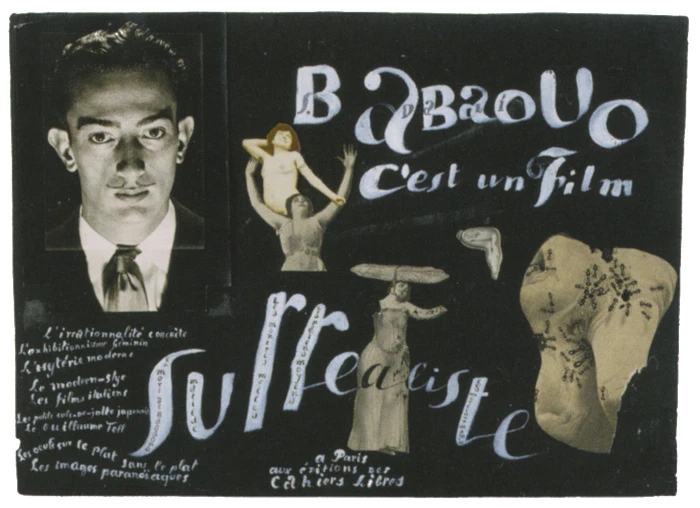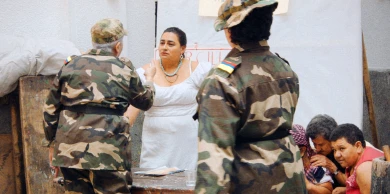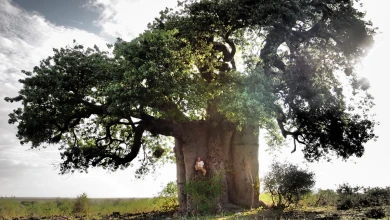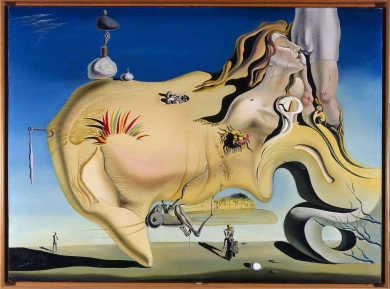-
30-31 August
Session 1. Film
Luis Buñuel. Un Chien Andalou ( An Andalusian Dog ) 1929. B/W, in French, with Spanish subtitles.
Courtesy of Filmoteca Española, Madrid.Luis Buñuel. L’Âge d'Or ( The Golden Age) 1930. B/W, in French, with Spanish subtitles.
Courtesy of Centre Pompidou, Musée National d’Art Moderne, Paris . Donation made in 1989. Original negative restored in 1993 by the Centre Pompidou, Musée National d’Art Moderne, with help from the GAN Foundation for Cinema. 35 mm film courtesy of Filmoteca Española , Madrid . Screenings in 35 mm on Friday at 4:30 p.m. and Saturday at 12 noon.Salvador Dalí with Walt Disney. Destino, 1946-2003. Colour, sound, no dialogue, 6’31’’.
Courtesy of Walt Disney Animation Studios. Film screened only on Friday at 4:30 p.m. and Saturday at 12 noon.Alfred Hitchcock. Spellbound , 1945. B/W, in English, with Spanish subtitles, 2’45’’. Fragment with sets designed by Dalí.
Courtesy of Walt Disney / ABC Domestic Television.Duration of the session: 1h 37 min
* Image rights of Salvador Dalí reserved. Fundació Gala-Salvador Dalí, Figueres, 2013
-
30-31 August
Session 2. Television. Advertisements. Happenings
A fondo . Joaquín Soler Serrano interviews Salvador Dalí, 1977. B/N, 46’
In collaboration with RTVE.*Advertisement for Chocolat Lanvin, 1969. Colour, in French, with Spanish subtitles. 25’’
Courtesy of La Maison de la Publicité *Salvador Dalí working on the two pieces Pastor de Ampurdán and La sirena alada de la Costa Brava to decorate Iberia airlines DC-10 aircraft, 1972. Colour, 1’ 21’’
Courtesy of the Iberia Documentation Centre. *Advertisement for Alka-Seltzer, 1974. Colour, in English, with Spanish subtitles. 44’’ Archives of the Bayer Corporation.
Courtesy of Bayer HealthCare LLC. *Happenings and actions Salvador Dalí happening in Park Güell. Tribute to Gaudí, 1956. B/W NO-DO Archives. Courtesy of Filmoteca Española. *
Dalinian Variations , Dalí on the beach and at his Port Lligat house presenting an invention that enables a sea urchin to paint a picture, 1957. B/W NO-DO Archives. Courtesy of Filmoteca Española. *
Salvador Dalí happening held in Park Güell for Harkness Ballet , 1966. B/W NO-DO Archives. Courtesy of Filmoteca Española. *
Fragment of the Salvador Dalí happening in Granollers. Dalí and his new invention. Rain Painting , 1974. B/W NO-DO Archives. Courtesy of Filmoteca Española. *
Salvador Dalí the baker, 1958. B/W, in French, with Spanish subtitles.
Courtesy of Institut National de l’Audiovisuel (INA), France . *
Ovociped , 1959. B/W, in French, with Spanish subtitles.
Courtesy of Institut National de l’Audiovisuel (INA), France . *Lecture by Dalí at the École Polytechnique, Paris , 1961. B/W, in French, with Spanish subtitles.
Courtesy of Institut National de l’Audiovisuel (INA), France . *Salvador Dalí, Journal de Paris. Dalí presents his collection of swimsuits. Dalí-kinis , 1964. B/W, in French, with Spanish subtitles.
Courtesy of Institut National de l’Audiovisuel (INA), France . *Salvador Dalí. Lorca, poetry phenomenon . Fragment in which Paco Ibáñez sings to Lorca and Dalí talks about him, 1965. B/W, in French, with Spanish subtitles.
Courtesy of Institut National de l’Audiovisuel (INA), France . *Salvador Dalí with Philippe Halsman, Chaos and Creation , 1960. B/W, in English, with Spanish subtitles, 18’26’’.
Courtesy of Philippe Halsman Archive , New York .Dizzy Dali Dinner , 1941. B/W, no sound, 52’’
Courtesy of Grinberg Asset Holdings.*Le Veston aphrodisiaque ( The Aphrodisiac Jacket ), 1964. B/W, in French, with Spanish subtitles, 45’’ Courtesy of Institut National de l’Audiovisuel (INA), France . *
Duration of the session: 1 h 34 min
* Image rights of Salvador Dalí reserved. Fundació Gala-Salvador Dalí, Figueres, 2013
-
30-31 agosto
Session 3. Documentary film
Jean-Christophe Averty.Soft Self-Portrait of Salvador Dalí (Autoportrait mou de Salvador Dalí), 1966. Colour, in French with Spanish subtitles, 70’
Courtesy of Jean-Christophe Averty and Institut National de l’Audiovisuel, INA, France *Duration of the session: 1 h 10 min
* Image rights of Salvador Dalí reserved. Fundació Gala-Salvador Dalí, Figueres, 2013
-
30-31 August
Schedule
Friday, August 30th
11:00 a.m. Session 1. Cinema
1:00 p.m Session 2. Advertisements. Television. Happenings.
3:00 p.m. Session 3. Documentary film
4:30 p.m. Session 1. Cinema
** Screening of L' Âge d'Or and Destino in 35 mm
Saturday, August 31st
11:00 a.m. Session 2. Advertisements. Television. Happenings.
1:00 p.m Session 1. Cinema
** Screening of L' Âge d'Or and Destino in 35 mm
3:00 p.m. Session 3. Documentary film.
4:30 p.m. Session 2. Advertisements. Television. Happenings.
6:30 p.m. Session 3. Documentary film.
8:00 p.m. Session 1. Cinema
10:00 p.m. Session 2. Advertisements. Television. Happenings.

Held on 30, 31 ago 2013
This audiovisual series looks at Salvador Dalí's film, video and television production, as a culmination of the exhibition Dalí. All of the poetic suggestions and all of the plastic possibilities. Almost five hours in length, this collection of works, with repeat screenings over two days, argues that the relationship between Dalí and mass culture is key to understanding the artist's work, but also to developing a different idea of modernity, one that conveys the spectacular and tumultuous nature of 1930s modernity.
The connection between mass media and modern art was understood, during most of that decade, through a complex body of theories. These modes of thinking, which ranged from formalist critique to the most orthodox surrealism, reveal the presence of an inevitable dialectical tension. So, it is no surprise that Clement Greenberg would situate the survival of the avant-garde in its direct confrontation with the kitsch of film and illustration. Similarly, André Breton would conceive of the manifestations of popular culture in surrealism as a simple means by which to transcend everyday life and once again enchant the world with the marvellous. The definitions proposed by the theorists of the time, such as Siegfried Kracauer, present cinema as an entertainment factory, in which the seriality and division of labour, typical of the industrial assembly line, are put to the service of merchandise transformed into spectacle.
Unlike theses such as these, which in one way or another protagonized the decade, Dalí's achievement was to formulate his own conception of the mass media, and his ideas took concrete form in the series of audiovisual productions presented in this series. In contrast with the mechanical and standardised work described by Kracauer, Dalí conceived of the film industry as a machine for the collective production of desire, in which the spectacle is the sequenced version of the paranoiac-critical method and its delirious associations. The public and the masses urgently demand the illogical and tumultuous images of their own desires and their own dreams (…), in Hollywood I hear the word Surrealism from every mouth, he wrote in 1937. Therefore it is not strange at all that Dalí would comment to Buñuel that, after all, L'Age d'Or is nothing but another American movie.
After two collaborations with his friend at the Residencia de Estudiantes in Madrid (Un Chien Andalou and L'Àge d'Or), Dalí's attraction to the subversive potential of Hollywood and mass culture, so liberating and spontaneous, prompted him to take part in film projects with Walt Disney (a genuine surrealist, along with Harpo Marx and Cecil B. DeMille, Dalí said of Disney) and Alfred Hitchcock. Dalí's originality lies in the fact that, unlike André Breton, he does not idealize or transcend this subculture, but rather promotes, somewhat like the surrealist dissident Georges Bataille, its low and degrading, anti-artistic nature. The artist conceived of himself as a Gargantua that executes and celebrates this collective manifestation of delirium.
So, although this new relationship between artist and spectacle led Breton to expel Dalí from the Surrealist movement - and rename him Avida Dollars - , the creator of The Great Masturbator did become the protagonist of numerous advertisements, documentaries, happenings and various actions undertaken by a generation of younger artists. In doing so, he not only revealed his ability to put forward a specific role of the artist within the mediatic world of post-war art, he also offered a solution, questionable or not, to another endless enigma, that of the relationship between modernity and the mass media.
Más actividades

CLINIC 2628. A Community of Writing and Research in the Arts
February – October 2026
Clinic 2628 is a project which supports and brings together writings which stem from the intention to offer a space and sustainable time for research work in art and culture. Framed within an academic context which is increasingly less receptive to the forms in which thinking happens and is expressed, the aim is to rescue the academic from its neoliberal trappings and thus recover the alliance between precision and intuition, work and desire. A further goal is to return writing to a commons which makes this possible through the monitoring of processes and the collectivisation of ideas, stances, references and strategies.
The endeavour, rooted in a collaboration between the Museo Reina Sofía’s Studies Directorship and the Artea research group, via the i+D Experimenta project, is shaped by three annual editions conceived as spaces of experimentation, discussion and a demonstration of writings critical of what is put forward by today’s academia.
What forces, forms and processes are at play when writing about art and aesthetics? In academia, in museums and in other cultural institutions, the practice of writing is traversed by productivist logics which jeopardise rhythms of research and experimentation. The imposition of both scientism inherent in the structure of “the paper” and the quantifying of results which demand a criterion of quality and visibility sterilise and smoothen, from the outset, the coarseness that is particular to writing understood from the concrete part of language: phonic, graphic, syntactic and grammatical resistance connecting the language user to the community the language unites and activates. They also sterilise the roughness enmeshed in the same desire to write, the intuitive, clear and confusing pathways that once again connect the writer to those reading and writing, participating in a common good that is at once discovered and produced.
The progressive commercialisation of knowledge propelled by cognitive capitalism moves further away from the research and production of knowledge in artworks and artistic languages and practices. The work of curators and archive, criticism, performances and essays formerly saw a horizon of formal and emotional possibilities, of imagination that was much broader when not developed in circumstances of competition, indexing and impact. Today, would it be possible to regain, critically not nostalgically, these ways; namely, recovering by forms, and by written forms, the proximity between art thinking and its objects? How to write in another way, to another rhythm, with no more demands than those with which an artwork moves towards different ways of seeing, reading and being in the world?

The (legal) person and the legal form. Chapter II
8, 12, 15 January, 2026 – 16:00 to 19:00
As part of the Studies Constellation, the Study Directoship’s annual fellowship, art historian and theorist Sven Lütticken leads the seminar The (Legal) Person and the Legal Form: Theoretical, Artistic, and Activist Commitments to foster dialogue and deepen the hypotheses and questions driving his research project.
This project, titled Unacting Personhood, Deforming Legal Abstraction, explores the dominance of real abstractions—such as exchange value and legal form—over our processes of subjectivation, and asks how artistic practices can open up alternative ways of representing or performing the subject and their legal condition in the contemporary world.
The seminar consists of eight sessions, divided into three chapters throughout the academic year. While conceived as non-public spaces for discussion and collective work, these sessions complement, nourish, and amplify the public program of the Studies Constellation.
In this second chapter of the seminar, the inquiry into the aesthetics and politics of legal form continues with three sessions that pick up the discussions held in Chapter I but propose new lines of flight. The first session focuses on international law via the writings of the British author China Miéville, which allows us to reconsider the notion of the legal form –following Evgeny Pashukanis— and, through it, a variety of (people’s) tribunals. While the crucial concept of the legal person –as the right-holder central to the form of law— was debated in Chapter I, the second session focuses on attempts to extend personhood not (just) to corporations, but rather to nonhuman animals or ecosystems. Finally, the third session poses the question: how can groups and networks use officially recognized organizational forms (such as the foundation or the cooperative) and/or use a collective persona (without necessarily a legal “infrastructure” to match) to act and represent themselves?

Oliver Laxe. HU/هُوَ. Dance as if no one were watching you
Tuesday, 16 December 2025 – 7pm
As a preamble to the opening of the exhibition HU/هُوَ. Dance as if no one were watching you, film-maker Oliver Laxe (Paris, 1982) engages in conversation with the show’s curators, Julia Morandeira and Chema González, touching on the working processes and visual references that articulate this site-specific project for the Museo Reina Sofía. The installation unveils a new programme in Space 1, devoted from this point on to projects by artists and film-makers who conduct investigations into the moving image, sound and other mediums in their exhibition forms.
Oliver Laxe’s film-making is situated in a resilient, cross-border territory, where the material and the political live side by side. In HU/هُوَ. Dance as if no one were watching you, this drift is sculpted into a search for the transcendency that arises between dancing bodies, sacred architectures and landscapes subjected to elemental and cosmological forces. As a result, this conversation seeks to explore the relationship the piece bears to the imagery of ancient monotheisms, the resonance of Persian Sufi literature and the role of abstraction as a resistance to literal meaning, as well as looking to analyse the possibilities of the image and the role of music — made here in collaboration with musician David Letellier, who also works under the pseudonym Kangding Ray — in this project.
These inaugural conversations, part of the main working strands of the Museo’s Public Programmes Area, aim to explore in greater depth the exhibition narratives of the shows organised by the Museo from the perspective of artists, curators and specialists.

Manuel Correa. The Shape of Now
13 DIC 2025
The Shape of Now is a documentary that explores the challenges and paradoxes of memory, reparation and post-conflict justice, extending a defiant and questioning gaze towards the six-decade armed conflict in which the Colombian State, guerrillas and paramilitary groups clashed to leave millions of victims in the country. The screening is conducted by the Aesthetics of Peace and Desertion Tactics study group and includes a presentation by and discussion with the film’s director, Manuel Correa.
The film surveys the consequences of the peace agreements signed in 2016 between the Colombian State and the FARC guerrilla organisation through the optics of different victims. It was recorded shortly after this signing, a time in which doubts lingered over the country’s future, with many groups speculating in the narration. Correa harnesses the power of images, visual and bodily memory, fiction and re-staging as tools for understanding the conflict, memory and healing, as well as for the achievement of a just peace that acknowledges and remembers all victims.
The activity is framed inside the research propelled by Aesthetics of Peace and Desertion Tactics, a study group developed by the Museo’s Study Directorship and Study Centre. This annual group seeks to rethink, from a theoretical-critical and historical-artistic perspective, the complex framework of concepts and exercises which operate under the notion of pacifism. A term that calls on not only myriad practices ranging from anti-militarism and anti-war movements to activism for non-violence, but also opens topical debates around violence, justice, reparation and desertion.
Framed in this context, the screening seeks to reflect on propositions of transitional and anti-punitive justice, and on an overlapping with artistic and audiovisual practices, particularly in conflicts that have engendered serious human rights violations. In such conflicts, the role played by audiovisual productions encompasses numerous challenges and ethical, aesthetic and political debates, among them those related to the limits of representation, the issue of revictimisation and the risks involved in the artistic commitment to justice. These themes will be addressed in a discussion held after the session.

Francisco López and Barbara Ellison
Thursday, 11 December - 8pm
The third session in the series brings together two international reference points in sound art in one evening — two independent performances which converse through their proximity here. Barbara Ellison opens proceedings with a piece centred on the perceptively ambiguous and the ghostly, where voices, sounds and materials become spectral manifestations.
This is followed by Francisco López, an internationally renowned Spanish sound artist, who presents one of his radical immersions in deep listening, with his work an invitation to submerge oneself in sound matter as a transformative experience.
This double session sets forth an encounter between two artists who, from different perspectives, share the same search: to open ears to territories where sound becomes a poetic force and space of resistance.




![Miguel Brieva, ilustración de la novela infantil Manuela y los Cakirukos (Reservoir Books, 2022) [izquierda] y Cibeles no conduzcas, 2023 [derecha]. Cortesía del artista](https://recursos.museoreinasofia.es/styles/small_landscape/public/Actividades/ecologias_del_deseo_utopico.jpg.webp)
![Ángel Alonso, Charbon [Carbón], 1964. Museo Reina Sofía](https://recursos.museoreinasofia.es/styles/small_landscape/public/Actividades/perspectivas_ecoambientales.jpg.webp)